For the 2025 school year, there is 1 public high school serving 488 students in Bledsoe County School District. This district's average high testing ranking is 3/10, which is in the bottom 50% of public high schools in Tennessee.
Public High School in Bledsoe County School District have an average math proficiency score of 17% (versus the Tennessee public high school average of 23%), and reading proficiency score of 31% (versus the 40% statewide average).
Public High School in Bledsoe County School District have a Graduation Rate of 92%, which is more than the Tennessee average of 90%.
The school with highest graduation rate is Bledsoe County High School, with 90-94% graduation rate. Read more about public school graduation rate statistics in Tennessee or national school graduation rate statistics.
Minority enrollment is 7% of the student body (majority Hispanic), which is less than the Tennessee public high school average of 42% (majority Black).
Overview
This School District
This State (TN)
# Schools
5 Schools
507 Schools
# Students
1,650 Students
327,116 Students
# Teachers
116 Teachers
21,160 Teachers
Student : Teacher Ratio
14:1
14:1
District Rank
Bledsoe County School District, which is ranked within the bottom 50% of all 147 school districts in Tennessee (based off of combined math and reading proficiency testing data) for the 2021-2022 school year.
The school district's graduation rate of 90-94% has increased from 85-89% over five school years.
Overall District Rank
#118 out of 147 school districts
(Bottom 50%)
(Bottom 50%)

Math Test Scores (% Proficient)
21%
31%

Reading/Language Arts Test Scores (% Proficient)
29%
37%

Science Test Scores (% Proficient)
33%
40%
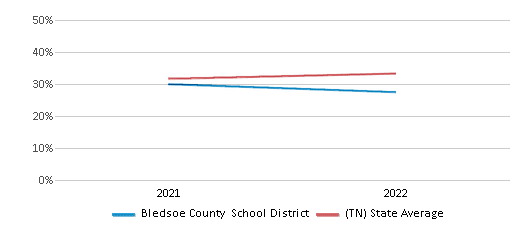
Graduation Rate
90-94%
90%
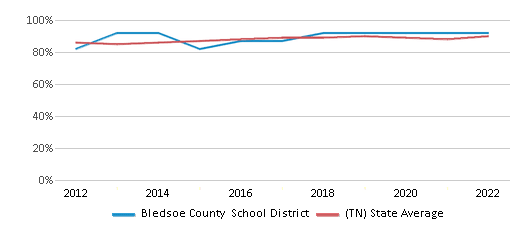
Students by Ethnicity:
Diversity Score
0.18
0.60
# American Indian Students
6 Students
563 Students
% American Indian Students
n/a
n/a
# Asian Students
3 Students
6,924 Students
% Asian Students
n/a
2%
# Hispanic Students
125 Students
48,246 Students
% Hispanic Students
8%
15%
# Black Students
23 Students
66,689 Students
% Black Students
1%
20%
# White Students
1,486 Students
191,311 Students
% White Students
90%
59%
# Hawaiian Students
n/a
351 Students
% Hawaiian Students
n/a
n/a
# Two or more races Students
7 Students
13,032 Students
% of Two or more races Students
1%
4%
Students by Grade:
# Students in PK Grade:
92
912
# Students in K Grade:
126
872
# Students in 1st Grade:
106
902
# Students in 2nd Grade:
126
947
# Students in 3rd Grade:
121
981
# Students in 4th Grade:
107
1,031
# Students in 5th Grade:
118
1,744
# Students in 6th Grade:
121
4,748
# Students in 7th Grade:
132
7,652
# Students in 8th Grade:
113
8,282
# Students in 9th Grade:
124
77,036
# Students in 10th Grade:
125
77,259
# Students in 11th Grade:
117
73,989
# Students in 12th Grade:
122
70,761
# Ungraded Students:
-
-
District Revenue and Spending
The revenue/student of $13,152 is higher than the state median of $11,979. The school district revenue/student has stayed relatively flat over four school years.
The school district's spending/student of $12,195 is higher than the state median of $11,478. The school district spending/student has stayed relatively flat over four school years.
Total Revenue
$22 MM
$12,104 MM
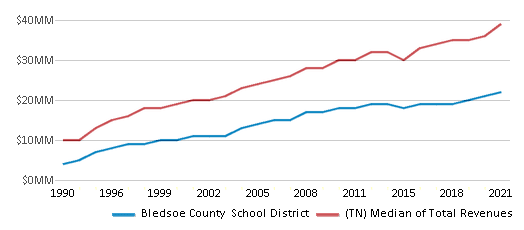
Spending
$20 MM
$11,597 MM
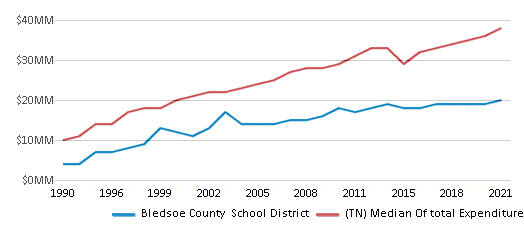
Revenue / Student
$13,152
$11,979
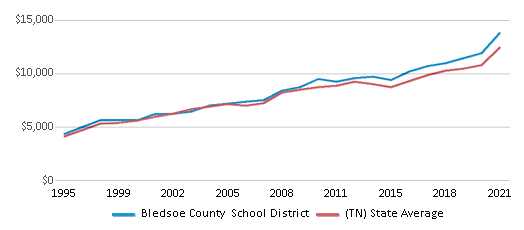
Spending / Student
$12,195
$11,478

Best Bledsoe County School District Public High Schools (2025)
School
(Math and Reading Proficiency)
(Math and Reading Proficiency)
Location
Grades
Students
Rank: #11.
Bledsoe County High School
(Math: 17% | Reading: 31%)
Rank:
Rank:
4/
Bottom 50%10
877 Main St
Pikeville, TN 37367
(423) 447-6851
Pikeville, TN 37367
(423) 447-6851
Grades: 9-12
| 488 students
Recent Articles

Year-Round Or Traditional Schedule?
Which is more appropriate for your child? A year-round attendance schedule or traditional schedule? We look at the pros and cons.

Why You Should Encourage Your Child to Join a Sports Team
Participating in team sports has a great many benefits for children, there is no doubt. In this article you will learn what those benefits are.

White Students are Now the Minority in U.S. Public Schools
Increasing birth rates among immigrant families from Asia and Central and South America, combined with lower birth rates among white families, means that for the first time in history, public school students in the United States are majority-minority. This shift in demographics poses difficulties for schools as they work to accommodate children of varying language abilities and socio-economic backgrounds.





